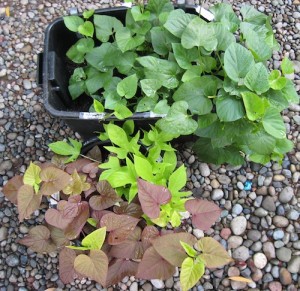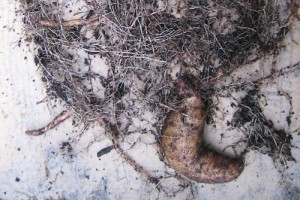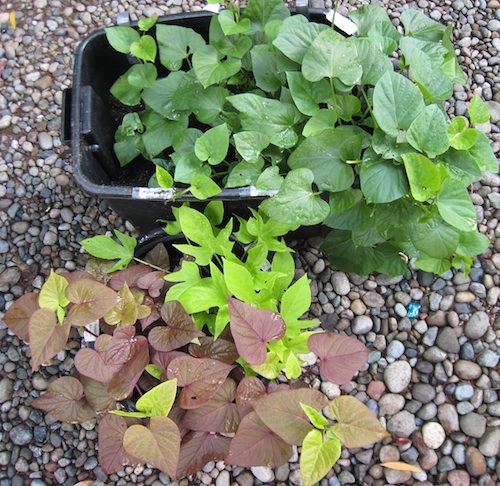During 2010, I tried to grow sweet potatoes in Seattle.

Briefly summarized: I learned that cultivars vary immensely and that growing sweet potato plants for their edible leaves is well worthwhile; but for their swollen roots alone, I found them not worth space in a garden here.
The sweet potato is well known as a crop adapted to, and thriving in, warm and hot places. It is easy to grow there. Gardening books assign it USDA climate zones 9 through 12.
In terms of its cultural preferences, it has little in common with its unrelated namesake the common potato Solanum tuberosum L. The latter is in another plant family (Nightshade), requires little summer warmth, and its leaves are poisonous even cooked.
A nutrient comparison of the common or Irish potato, and the sweet potato, reveals that compared to common potatoes, sweet potatoes are higher in fat, lower in protein; higher in minerals; way higher in vitamin A.
About 650 species of Ipomoea exist, primarily in tropical and warm-temperate regions. The common sweet potato, Ipomoea Batatas, originated in Central America. Domestication occurred before 6,500 years ago. It is now grown globally wherever the climate permits and is especially prized in China.
The specific name batatas or batata dates from the 1500s –the Spanish name patata, from Carib [Haiti] batata (sweet potato). After the first voyage of Columbus in 1492, sweet potato was introduced to Europe.
Cultivars of Ipomoea batatas have been selected and grown for 3 main reasons:
- Edible swollen roots (the main role; Stephen Facciola’s book, Cornucopia II (1998), catalogs 9 “dry flesh” cultivars and 16 “moist flesh” ones in commerce; their color can be white, yellow, orange or purple)
- Edible leaves (rich in protein; “sweet potato spinach”)
- Ornamental foliage grown as summer annuals
Sweet potato leaves are hairless, often shiny, thick, variably shaped, and nutritious. They have milky juice. They grow on trailing, vine-like stems. Flowers are rarely seen in the North and appear late in the growing season.
Commonly in the United States, at Thanksgiving, people serve sweet potatoes, and call them yams. According to SweetPotato.org, “African slaves in the South called the sweet potato nyami because it reminded them of the starchy, edible tuber of that name that grew in their homeland. The Senegalese word nyami was eventually shortened to the word yam.”
Few residents of these states know that the leaves are also edible and highly nutritious. A 2006 article, Nutritive and Anti-nutritive Evaluation of Sweet Potatoes Leaves, points out “Its wide use as vegetable is however hampered by the fact that it is considered a poor man’s vegetable, coupled with the fact that it had always been used traditionally as feeds for domestic animals.”
The study concludes:
“The leaves of Ipomoea batatas from the data, reveals that it contains an appreciable amount of proteins, minerals, fat, fibre, carbohydrate, caloric values (energy) and low levels of toxicants except for oxalate whose value can be reduced by cooking.”
I tried to grow in Seattle, this year, 10 sweet potato cultivars. Knowing that they require heat to yield well, and that Seattle is notably lacking in summer heat, I needed care. A.R. Kruckeberg’s 1995 book, The Natural History of Puget Sound Country, reports:
“Western Washington, where the sun just skirts the southern horizon in winter, has the lowest heat budget level of any place in the United States, outside Alaska.”
That is why it is difficult in Seattle to raise large crops of tomatoes, melons, peppers, eggplants, and the like.
Moreover, my garden is notably shady due to many trees. Therefore, to maximize my yield, I planted all the sweet potato starts in black plastic tubs, and as they grew, raised the level of compost, supplemented with fertilizer. The tubs were put in relatively sunny places, and watered amply.
The results? Of the 5 “ornamental” cultivars, Blackie, Margarita and Sweet Georgia Heart Purple all croaked as if they rotted; Sweet Caroline Light Green and Sweet Caroline Sweetheart Red made pretty, edible foliage, but no swollen roots. It should be mentioned that this 2010 spring and summer were unusually cool even for Seattle standards. This was a poor year, and my garden a poor site, to try a sweet potato experiment. Possibly I gave the plants too much nitrogen.

Of the 5 production cultivars, Centennial and O Henry died early; Bush Porto Rico made adequate greens but no thickened roots; Georgia Jet was a strong grower of good foliage, but no swollen roots. Beauregard alone made both good foliage and one plump root.
But that Beauregard grew a sweet potato – even in these difficult circumstances – is gratifying. Beauregard was released by the Louisiana Agricultural Experiment Station in 1987. It is the leading cultivar now in the United States.
Besides those ten, there are two more. In September I mail-ordered from Flora Exotica an unnamed cultivar in a small pot, and in October from Glasshouse Works a purple tuber clone. These two I shall grow overwinter as houseplants. Their leaves, cooked, shall feed me. I have enjoyed sweet potato leaves cooked via stir-fry, and used as one would spinach, added to pasta dishes or topping a vegetarian pizza.
How to cook my lone Beauregard potato is something to mull over.
About Arthur Lee Jacobson
A lifelong Seattle resident, Arthur developed a passion for plants at 17 and has made his living growing, photographing, and writing about plants. He is a rare expert who can speak about wild plants, garden plants, and house plants.
Arthur has a special interest in edible plants, and, in his field guide Wild Plants of Greater Seattle, he includes comments on the edibility, taste, and uses of plants found in the city.
For more information, visit Arthur Lee Jacobson’s website.
Photos: ©2010, Arthur Lee Jacobson


Glad you liked my article. Thanks for sharing your thoughts. Inasmuch as sweet potatoes are inexpensive to buy, and difficult to grow in Seattle as a root crop, their main value here may be for their greens. I plan to set out some in summer, and compare their foliage production and flavor. I will try, perhaps, 3 different clones, each root weighing about 1 pound, each planted in a 5-gall. black plastic pot. Since greenery is the goal, ample nitrogen will be supplied.
Arthur Lee Jacobson
Hi Arthur,
Great post and I am even more impressed that you are growing the sweetpotatoes primarily for the leaves! Growing up, sweetpotato greens were a favorite of mine.
I commented about your post in my little blog and titled it “Rootless in Seattle.”
As a person who works with sweetpotatoes from the research side of things, I can offer some ideas as to why you only had one Beauregard root.
A closer examination of the growing environment, as evidenced from the photographs, offer some clues. First, the plants were grown in pots, apparently in some potting mix(?) While this is not undesirable per se, poor drainage in such an environment can mimic flooding conditions that leads to oxygen deprivation in the root zone that eventually leads to reduced storage root development. From the lower picture showing the lone Beauregard storage root, there are indications of the presence of “pencil roots” at the 8:00 and 10:00 o’clock positions. Pencil roots are heavily lignified adventitious roots. If these adventitious roots were not lignified, these would have become storage roots. Stress has been implicated as a cause of lignification. In this case, drought stress was not likely the cause, assuming water was applied. However, too much water, especially in the bottom of the pot could not be ruled out. Still another possible cause is the lack of growth in the shoot due to shading and low temperatures. Beauregard storage roots generally do well in the 74 to 90F range. Under these conditions, storage roots can be harvested at 115 days.
It is surprising that Georgia Jet did not “out-yield” Beauregard in the Seattle area. In Canada, GA Jet is commonly grown because it is perceived to be an “early” cultivar. Although Seattle’s growing environment is not a complete replica of Canada’s gardens (in and around the Ontario area), the “shortened” (i.e., lack of growing degree days typical of southern locations) growing environment appears to be more or less similar.
As for your lone Beauregard root, if you haven’t already baked it, I suggest bedding it for the 2011 crop!
Thanks and good luck.